
- SAP Community
- Products and Technology
- Additional Blogs by Members
- An old dog tries new tricks - CCMS II / ADM107 - A...
- Subscribe to RSS Feed
- Mark as New
- Mark as Read
- Bookmark
- Subscribe
- Printer Friendly Page
- Report Inappropriate Content
Previously, I shared what I learned in the ADM107 class and how we we applying these lessons
to our enterprise systems. As the teams face other challenges on the way, the completion of
our initial goal of a set of business transaction metrics remains elusive.
On June 2nd, we got time on Dieter's calendar for knowledge transfer, debugging, and road map planning. Next time I think I'll ask if we can record him, perhaps for some E-learning.
Below is the chronology of our progress, with events both before and after our chat:
h4. 08:33Before getting started, there were remnants of prior attempts to set up monitoring.
Values are visible in the RZ20 monitoring tree hierarchy, but no data were being collected.

09:24
The database table ALTRAMONI had 1 row.

!CPH-DEV-VA02-altramoni.png|alt=|src=CPH-DEV-VA02-altramoni.png!
At 09:27, we added 1 row to ALTRAMONI as follows:
Transaction RZ23N, then
Extended, then
Extended CPH Settings
h4. Online Help
Dieter said to search help.sap.com
for ALTRAMONI,
which produced 2 pages:
- [Monitoring Response Times of Transactions or Clients | http://help.sap.com/erp2005_ehp_03/helpdata/EN/a7/81414e8c5411d3b486006094b910d9/frameset.htm]
</li></ul>

As we couldn't wait for the next data cycle, we forced a run with:
RSPFDB_SEL_COLLECT
on the central system.
h4. 09:39

We also triggered:
SAPMMSY8
on the satellite system,
which moves data? (Dieter, little help here again please?)

After verifying data is now being collected on the source/satellite system, we looked at the target/central system.
SM37 (Job Overview) on the central system shows the PFDB (performance database) job only ran when we forced it:
SAP_CCMS_PFDB_COUP_DEV JSPATH Finished 06/02/2008 09:51:27 8 0
SAP_CCMS_PFDB_COUP_DEV JSPATH Finished 06/02/2008 09:52:54 1 0
SAP_CCMS_PFDB_COUP_DEV JSPATH Finished 06/02/2008 09:53:11 2 0
SAP_CCMS_PFDB_COUP_DEV JSPATH Finished 06/02/2008 09:53:28 2 0
SAP_CCMS_PFDB_COUP_DEV JSPATH Finished 06/02/2008 09:54:03 1 0
SAP_CCMS_PFDB_COUP_DEV JSPATH Finished 06/02/2008 09:54:21 1 0
There was a tangential discussion on how to set up the central system so we don't need to configure each satellite system.
We didn't totally understand what Dieter said, so we need to follow up as to whether this is practical, desirable, necessary, or even possible.

Houston, we have data!
09:58


The times are off (seem to be showing GMT, not local time), and as of yet, no records have appeared beyond the 10:00 time, but there is data in the CPH system!
10:22
Later, I added a transaction I'm more familiar with (ST10 - table buffer performance). This will help in determining the match between when transactions occur, when they are moved to the CPH, and when the CPH shows they happened.
h4. 13:30I also decreased the time between collections.

Here's what ALTRAMONI has now.
</p>h4. 13:36

The MTE Focus Groups
We had difficulty identifying the monitoring tree element that would initiate transaction specific monitoring, so we picked several that had the term "Focus" in them. Dieters tip was to use the search function, as scrolling through the list was not showing us what we needed. I don't think assigning extra mappings will have any negative effect.
| !/weblogs/images/251822835/ContextR3DialogFocus.png|alt=|src=/weblogs/images/251822835/ContextR3DialogFocus.png! | !/weblogs/images/251822835/R3DialogFocusClient.png|alt=|src=/weblogs/images/251822835/R3DialogFocusClient.png! | !/weblogs/images/251822835/R3DialogFocusClientTransaction.png|alt=|src=/weblogs/images/251822835/R3DialogFocusClientTransaction.png! |
| !/weblogs/images/251822835/R3DialogFocusDbRequestTime.png|alt=|src=/weblogs/images/251822835/R3DialogFocusDbRequestTime.png! | !/weblogs/images/251822835/R3FocusDialogResponseTime.png|alt=|src=/weblogs/images/251822835/R3FocusDialogResponseTime.png! |
To help search engines later, here are the focus tokens:
- ContextR3DialogFocus
- R3DialogFocusClient
- R3DialogFocusClientTransaction
- R3DialogFocusDbRequestTime
- R3FocusDialogResponseTime
We've added the currently-defined critical business transactions to another development system to see if all will be collected after insertion into the ALTRAMONI table.
We're planning to add more than 10 transactions into another system to see what happens to number 11.
We will research the collection and transfer jobs, with the goal of putting these in our enterprise job scheduling system, so that we can better control and monitor the collection time, run frequency, and measurement duration.
- Question about creating contracts with reference to other contracts in SAP S/4HANA Cloud Public. in Enterprise Resource Planning Q&A
- Introducing SAP Concur’ s Identity and User Provisioning Webservices in Enterprise Resource Planning Blogs by SAP
- What Happens When SAP GTS 11.0 Runs Out of Mainstream Maintenance? in Financial Management Blogs by SAP
- OCC ABAP Cleaners OR How to tidy up the Core in Enterprise Resource Planning Blogs by Members
- Exploring the world of SAP-BTeaP OR Beware Stormy BTeaP Seas Ahead in Technology Blogs by Members
| User | Count |
|---|---|
| 1 | |
| 1 | |
| 1 | |
| 1 |